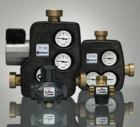Effective operation of wood boilers

ESBE has introduced a range of load units and load valves to maximise the energy efficiency of boilers using solid fuel (wood) and minimise their environmental impact. The range has been designed for optimal loading of accumulation tanks — from the smallest pellet stoves to 150 kW boilers.
Optimal regulation protects the boiler from low return temperatures, while the accumulation tank is efficiently loaded — with good layering.
To minimise emissions, a wood boiler needs a high combustion temperature. A low return temperature can lead to internal corrosion. The valves ensure a boiler gets up to temperature quickly and maintains a high return temperature throughout the combustion cycle. Benefits include fewer emissions of environmentally hazardous substances, reduced tar formation in the boiler and longer service life.
The load unit has an auto-circulation function that allows the tank to continue loading if there is a power cut or the circulation pump stops working. The load valve regulates at two ports, improving control performance and meaning that a separate adjustment valve is not required on the bypass pipe. To achieve high energy efficiency and operating economy, correctly dimensioned valves are essential, so EBSE’s range has 95 different standard variations.







